Police used teargas and non-lethal weapons to control Occupy Oakland protesters overnight after a general strike had effectively shut down the city's port and downtown areas.
There were three separate instances of police using teargas, all near to the Occupy camp, as tensions erupted when protesters occupied a disused building.
Earlier a thousands-strong march had closed down Oakland's port after a day of striking had seen streets closed in downtown and some banks damaged.
Police first used teargas on Broadway at 12.30am, following a day which had actually seen a light police presence.
Officers arrived on the street - the scene of the police clearout of Occupy Oakland on Tuesday 25 October which left Scott Olsen seriously injured - after protesters occupied a disused building on 16th Street.
Scores of protesters entered the building as loud music was played downstairs, some climbing onto the roof while others assessed the internet capabilities. By midnight a street party was in full swing outside the fresh property - but the hi-jinks were to be short-lived.
Sporadic reports of a growing police presence had been sweeping through the crowd, and finally about 200 police gathered at 19th Street and Broadway in full riot gear, walking slowly down to protesters.
Some demonstrators, keen to keep hold of their new occupation, had created a barricade of wooden pallets and rubbish bins at the corner of 16th Street and Broadway, and as police approached these were set alight.
Police stopped around 100m away before advancing again, with some protesters walking forward to meet them. Officers then deployed teargas and about three explosive devices, which were described by some present as flashbang grenades.
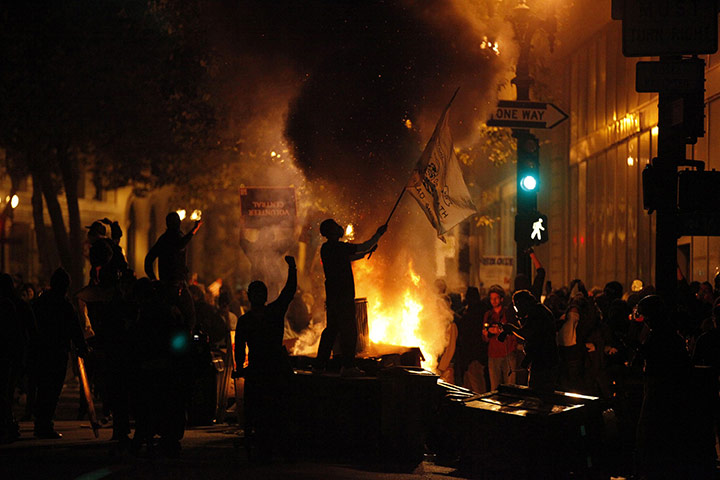
Again, police deployed teargas, but this time it seemed in greater concentration or quantity. As officers threw flashbang grenades to force protesters back - around 10 were used - this reporter witnessed two demonstrators hurl items in retaliation.
Lauren Freitas was among those caught up in the chaos, and said she had been struck on both legs by projectiles.
"I was tending to this guy's eyes [after the first teargas was deployed] and then they fired more teargas, so I pulled him to the side to move away and then they hit me in my legs."
Freitas said of the pain: "It fucking hurts. It stings."
The first two operations seemed to subdue the crowd, and by around 1.30am police controlled the north side of Broadway and had extinguished the blaze on 16th Street. Further bangs could be heard, however, to the east, from the direction of Frank H Ogawa plaza.
Teargas was again deployed there, and flashbang grenades and another type of non-lethal projectile appeared to have been used.
One man, who onlookers said was homeless and a regular in the area, appeared to have been hit on the knee by a projectile, and was carried away screaming. He received treatment from medics from Occupy Oakland.
The clashes marred what had been a largely peaceful day's protesting in Oakland. Demonstrators had called for a general strike, and thousand gathered in the streets of downtown in warm sunshine, listening to speakers and dancing, while every so often darting off on a sporadic march.
Although most of the marches were peaceful, at least three banks - Chase, Wells Fargo and Bank of America - were damaged during the day, with windows smashed and cash machines put out of service.
Much talk in the camp was of a rogue group having committed the acts, without the backing of most protesters.
Bubb Rubb, from Oakland, was unimpressed with "these people in black clothes, with black flags".
"They bamboozled us. They wanted violence," he told the Guardian.
Comment: That would be the undercover cops then.
Many of the sites that were vandalised bore posters next to where the incident had occurred, saying it was "not the actions of the 99%".
Organisers' main focus of the day was the march to the port, designed to shut it down by preventing workers from accessing it to begin their night shifts.
Thousands of people gathered at Frank H Ogawa plaza for the 5pm start of the march, which headed south and left contingents of protesters at four different sites to guard the port. By 8pm the port had been declared closed, with some demonstrators celebrating victory and others pledging to stay until Thursday.
"I think today went amazingly well," said Laura Long, speaking before police arrived on Broadway.
"We estimate up to 30,000 people passed through Occupy Oakland at some point today, and we were successful in shutting down the port."
Reports suggested police arrested about 60 people during the day, while at least one person was taken to hospital after being hit by a car during a march.
Reports suggested a silver Mercedes struck a man who was part of a slow-moving march.
Oakland police have faced huge criticism for taking charge of Tuesday 25 October's operation to clear Occupy Oakland after Scott Olsen suffered a fractured skull during the operation.
Before the march, however, the Oakland police officers' association criticised Mayor Quan for allowing city employees other than police to take Wednesday off, while simultaneously calling in all 645 Oakland officers to police the strike.
Quan tweeted at about midnight urging protesters to call her office, citing reports a barricade was set up on 16th Street. She tweeted shortly later saying that police had not yet taken action, but had not posted again at the time of writing.
While Oakland police have received much of the criticism for previous events in the city, on Wednesday night it was Alameda county sheriffs who appeared to be manning the confrontational end of the operation - their officers lining Broadway and apparently discharging the teargas and other weapons.
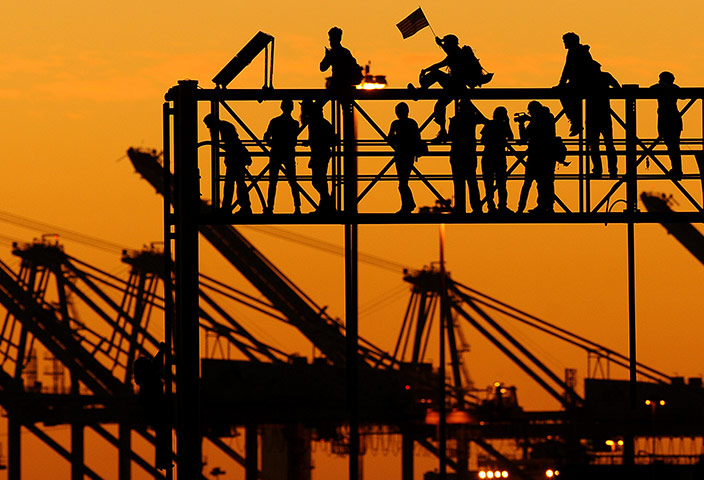
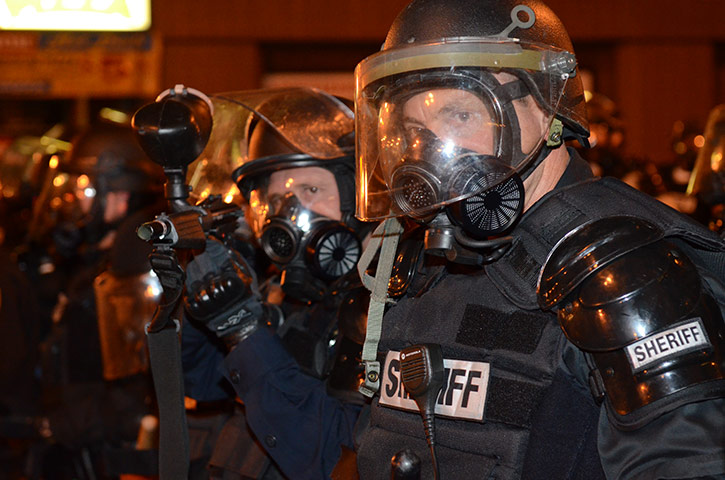
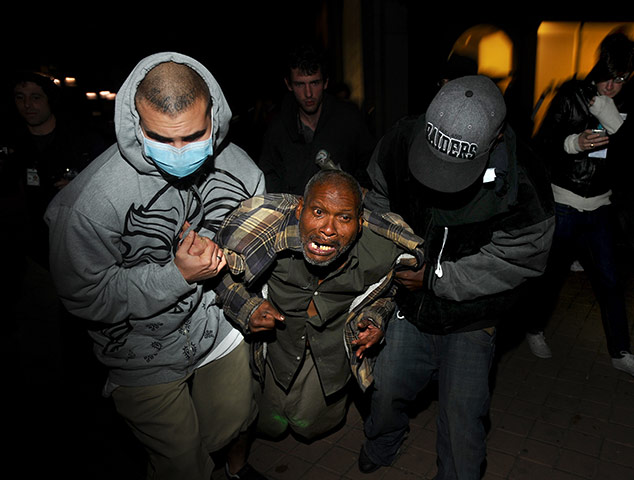
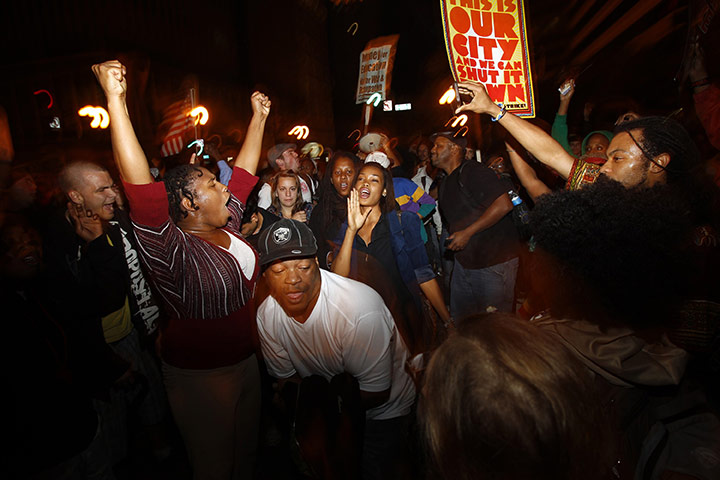
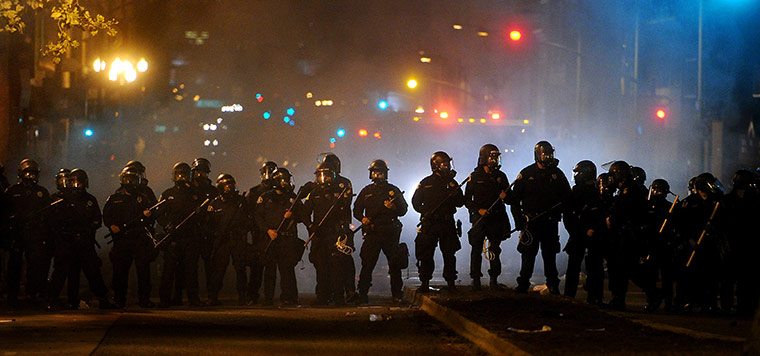
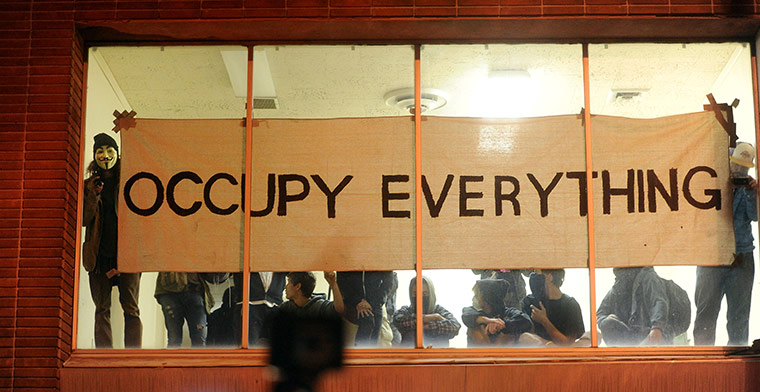



Well perhaps gas masks for the 99% are in order... For the grenades-well some baseball players with bats? I'm just saying.